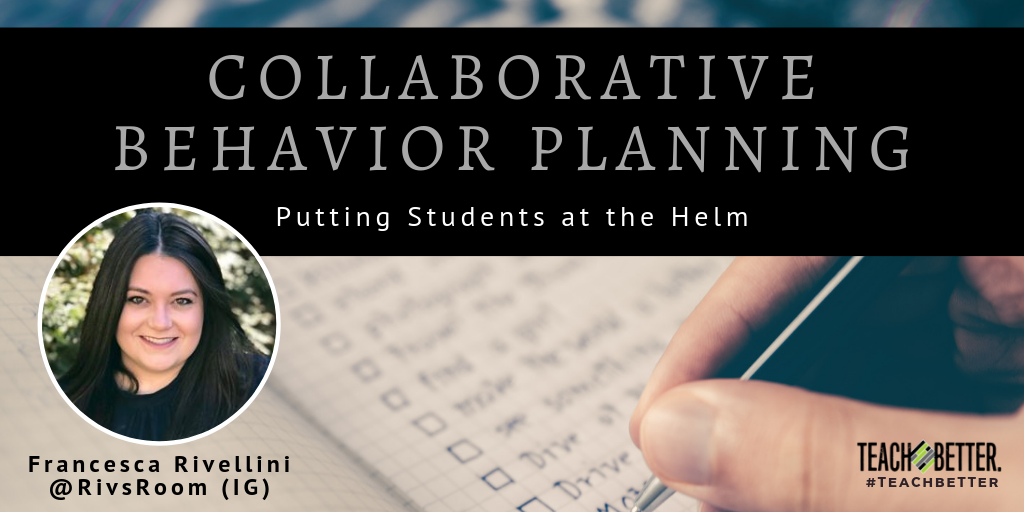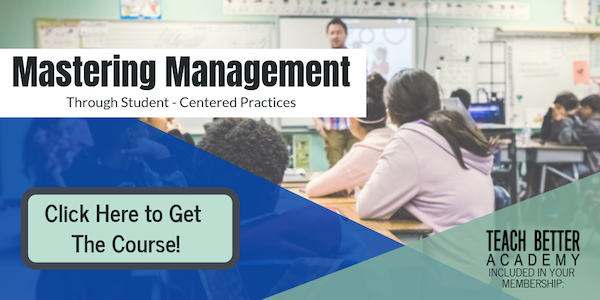In this post:
- Discover the biggest problem with most student behavior plans
- What is a student-led behavior plan?
- Steps to make a student-led behavior plan work for students and teachers
Let’s get this out in the open: implementing and designing behavior plans to improve the behavior of challenging students is not an easy task. Sometimes they work, and sometimes they don’t. And if you have ever had a student sabotage the behavior plan you worked so hard on, then you know the struggle.
Too often, students are provided with their behavior plans with no say in their creation and then have to follow them. When students are smart enough to recognize what’s going on, they often destroy the very plan that’s put in place to help them.
When we allow the student to recognize their powerful voice and make positive choices, we provide them with the self-awareness and critical thinking skills they need to be successful citizens. #TeachBetter Click To TweetThe reason each child does this is different. Some students feel confined or trapped by their plans. Other students feel that the plan has enormous expectations that they cannot possibly meet. And, almost always, the plan is not actually meeting the needs of the child or addressing the true function of the behavior.
When this happens, the adults in the situation often feel confused, exasperated, and burnt out. The kid is frustrated, disengaged from school, and annoyed or even angry. That’s why, whenever I’m developing behavior plans, I do something a little unconventional: I put the kid in charge.
Student-Led Behavior Plans
When I put students in charge of their own behavior plans, I’m usually met with some confusion or resistance. However, if we truly want learning to be student-led, kids need to have ownership of their behavior plans. That means we have to truly acknowledge the student as the most important person on the decision-making team, we have to build positive relationships with them, and we have to honor their ability to make critical decisions about what makes them successful. And, believe it or not, they are far more likely to abide by their plans when they have an important voice in the development and structure of their school day.
The conversation surrounding the development of the behavior plan should involve all key players – parents, teachers, administrators, and the student. Too often, we leave that last player out of the conversation.
[scroll down to keep reading]I understand that each situation is unique and different, and how to proceed is ultimately up to the professional discretion of the adults working with the student. You can begin with a small or large group, but remember the most important part is that the student gives significant input about the key pieces of the plan.
Starting the Conversation
The questions can below provide a conversational guide for developing a student-led behavior plan:
- Goal: What is our goal? Try to define the ideal behavioral situation. Lay out the expectations. Identify the non-negotiables in this plan.
- Reward: What are we working towards? What actions would result in rewards? (These rewards can be intrinsic or extrinsic, depending on the student.)
- Expectations: What specifically is expected of the student? What is expected of the teachers, administrators, staff, and parents?
- Behaviors of Concern: What would result in a negative consequence? What would the negative consequence be? How would this negative consequence teach the student not to engage in this behavior anymore?
- Needs & Supports: What do we need to reach our goal? What obstacles are preventing us from achieving this goal? How can we overcome them?
- Data Collection: How will we know that it’s been achieved? What do we need to do to keep track of this information?
Moving Forward
It’s important to remember that when a student engages in problematic behavior, they are trying to tell us something. Including students in the conversation provides an effective outlet to communicate their challenges.
Once the behavior plan is in place, continue to monitor and revise the plan as needed. Provide the student with a point-person they can go to when they feel the plan may need some revising. You will find that when the student is in charge, they are able to tell us what’s not working. This allows us to make effective, collaborative alterations to their plans in real time.
When we allow the student to recognize their powerful voice and make positive choices, we provide them with the self-awareness and critical thinking skills they need to be successful citizens.
About Francesca Rivellini
Francesca Rivellini is a Middle-Level Special Educator from New Jersey. She is also the Founder of Riv’s Room, which strives to support teachers as they instruct students with special needs. In 2017, Francesca was honored with the University of Hartford’s Alumni Giving Back Award for upholding the ideals of education in her teaching practice and the community she serves.
Check out Francesca’s Teachers Pay Teachers Resources: www.teacherspayteachers.com/Store/Rivs-Room




